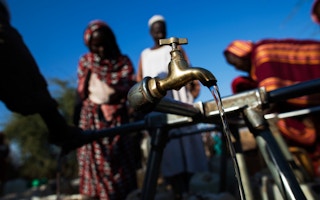“Day Zero” is now part of the lexicon of water management.
There are at least two things wrong with the term: The implication that it is an unavoidable surprise from mother nature, and that running out of water equally impacts everyone in society.
Both of these perceptions are wrong and will be perpetuated as long as we continue to refer to “Day Zero.”
It’s time for the public sector, businesses and civil society to implement real solutions to water scarcity and associated inequity.
In 2018, the city of Cape Town in South Africa introduced the idea of Day Zero to focus the public’s attention on managing water consumption by convincing residents to reduce water usage (Cape Town Day Zero ).
The four million residents of Cape Town were about three months away from “running out of water” (Cape Town One Year Later) authorities said. The city experienced three consecutive years of low rainfall and April 12, 2018, was to be the date of what was being called the largest drought-induced municipal water failure in modern history.
The city’s plan was for the entire population to collect its water (an estimated maximum of a two-minute shower’s-worth a day per person) from 200 centralized water centers. However, when April 12th rolled around, the city made it without turning off the taps.
A bit of luck and last-minute emergency water conservation measures managed to get the city through the crisis.
This sounds like a success story. It’s not. Here’s why.
Hope is not a strategy
The first mistake is assuming that the past is a guide to the future with regards to water supplies. Why was the public sector surprised by outcomes from a multi-year decline in precipitation and increased demand for water?
For many, there is an ongoing expectation that we are experiencing droughts that are similar to previous droughts and that a good rainfall is all we need to get back to normal.
But hope is not a strategy, and climate change has impacted the predictability of rainfall and snow-pack. This means the past is no longer a guide to the future. Coupled with an over-allocation of water and holding onto ‘business as usual’ water management practices, like low water conservation and reuse rates, creates a reactive water management response. Hence, “Day Zero.”

People queue to collect water from a spring in the Newlands suburb as fears over the city’s water crisis grow in Cape Town, South Africa, January 25, 2018. REUTERS/Mike Hutchings
The second mistake is that the supply/demand gap projections universally impact everyone equally, which is misleading.
The Charting our Water Futures report by global consultancy McKinsey predicted that by “2030, under an average economic growth scenario and if no efficiency gains are assumed, global water requirements would grow from 4,500 billion m3 today (or 4.5 thousand cubic kilometers) to 6,900 billion m3.”
This translates to 40 per cent above current accessible, reliable supply including return flows, and taking into account that a portion of supply should be reserved for environmental requirements.
As the report states, “the drivers of this resource challenge are fundamentally tied to economic growth and development. Agriculture accounts for approximately 3,100 billion m3, or 71 percent of global water withdrawals today, and without efficiency gains will increase to 4,500 billion m3 by 2030 (a slight decline to 65 per cent of global water withdrawals). The water challenge is therefore closely tied to food provision and trade.”
It is far too easy to view the supply/demand gap in some abstract term and that the gap will somehow equally impact all stakeholders. This is simply untrue.
Case in point: The October 2019 research by the World Resources Institute, Day Zero Water Crisis Lessons, which states, “the crisis revealed a dire picture of social inequity in both cities. While the rich could afford their own solutions, the poor had to wait for government help. For many of them, every day is Day Zero.”
“
There are at least two things wrong with the term: The implication that it is an unavoidable surprise from mother nature, and that running out of water equally impacts everyone in society.
There is no “gap” and declaring “Day Zero” is a reaction to poor water management by assuming the past is a guide to the future.
The United Nations’ Sustainable Development Goals (SDGs) establish an urgent call for countries and cities to create a resilient, sustainable and equitable future for everyone. The SDGs consist of 17 goals, including those for universal access to safe drinking water, sanitation and hygiene, to be met by 2030.
For goal 6, which states, “Ensure availability and sustainable management of water and sanitation for all,” we need innovative policies and technical solutions that consider equity.
Where do we go from here?
I believe 2020 will be the year we become more proactive and abandon reactive water strategies and rhetoric. There really is no other choice, as we are seeing increasing examples of what water scarcity and poor quality can do to degrade social well-being, ecosystem health, economic development and business growth.
We are also seeing advances in public policy for example the California Sustainable Groundwater Management Act and technology such as the IWA Digital Water Report and better financing of solutions.
Here’s to 2020 being a turning point once and for all on water.
Will Sarni is the founder of Water Foundry and an internationally recognised leader on water strategy and innovation.
This story was published with permission from Thomson Reuters Foundation, the charitable arm of Thomson Reuters, that covers humanitarian news, climate change, resilience, women’s rights, trafficking and property rights. Visit http://news.trust.org/climate.











